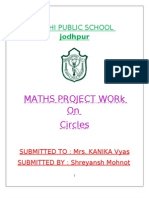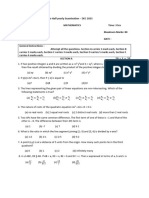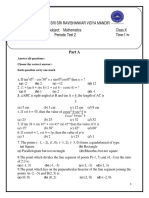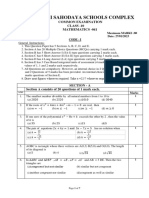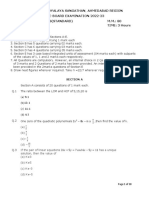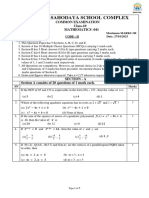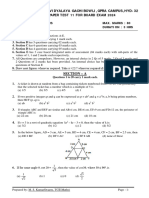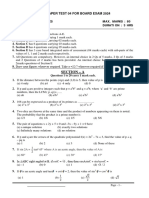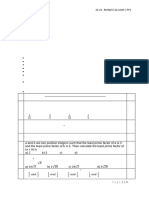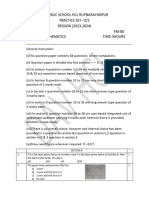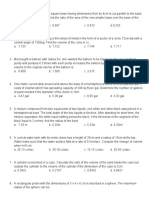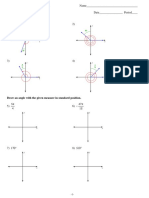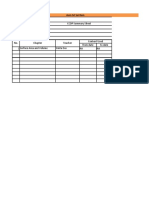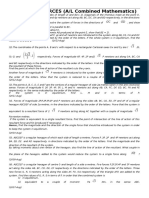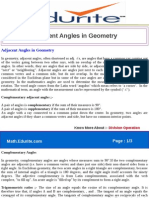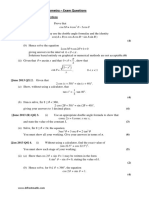Class-X - Preparatory Test I 2023-24 1.0
Class-X - Preparatory Test I 2023-24 1.0
Uploaded by
Nirmala DeviCopyright:
Available Formats
Class-X - Preparatory Test I 2023-24 1.0
Class-X - Preparatory Test I 2023-24 1.0
Uploaded by
Nirmala DeviCopyright
Available Formats
Share this document
Did you find this document useful?
Is this content inappropriate?
Copyright:
Available Formats
Class-X - Preparatory Test I 2023-24 1.0
Class-X - Preparatory Test I 2023-24 1.0
Uploaded by
Nirmala DeviCopyright:
Available Formats
CLASS – X
SUBJECT: Maths
Time: 3:00 hours M.M. - 80
Date: 02.01.2024
Instructions: (a) Please note down the test start and end time.
(b) Parents are requested to play the role of exam invigilator.
General Instructions:
1. The question paper has 5 sections A, B, C, D and E.
2. Section A consists of 20 multiple choice questions (MCQs) carrying 1 mark each.
3. Section B consists of 05 short answer type-I questions (SA-I) carrying 02 marks each.
4. Section C consists of 06 short answer type-II questions (SA-II) carrying 03 marks each.
5. Section D consists of 04 long answer type questions (LA) carrying 05 marks each.
6. Section E consists of 03 Case Based integrated units of assessment (04 marks each) with sub-parts of the value
1, 1 and 2 marks each respectively.
7. All questions are compulsory. However, an internal choice in 2 Qs of 02 marks, 2 Qs of 03 marks and 2 Qs of 05 marks
has been provided. An internal choice has been provided in the 02 marks questions of section E.
22
8. Draw neat figures wherever required. Take π= wherever required if not stated.
7
Section – A
Section – A consists of 20 questions of 1 mark each.
Q.1. If 𝑎 is an odd number, 𝑏 is not divisible by 3 and LCM of 𝑎 and 𝑏 is 𝑃 then the LCM of
3𝑎 and 2𝑏 is:
(a) 5𝑃 (b) 3𝑃 (c) 6𝑃 (d) 2𝑃
Q.2. Which of the following could be the graph of the polynomial (𝑥 − 1)2 (𝑥 + 2) ?
(a) (b)
(c) (d)
Compiled by Arulraj Ebenezer Page 1 of 7
Q.3. 𝑥 and 𝑦 are two different digits. If the sum of the two, 2-digit numbers that can be
formed by using the digits 𝑥 and 𝑦 and by reversing the digits is a perfect square, then
value of 𝑥 + 𝑦 is
(a) 10 (b) 11 (c) 12 (d) 13
Q.4. The lines 𝑘1 , 𝑘2 and 𝑘3 represent three different equations as shown in the graph below.
(𝑘1 ∥ 𝑘2 ) The solution of the equations represented by 𝑘1 and 𝑘3 is 𝑥 = 3 and 𝑦 = 0
while the solution of the equations represented by 𝑘2 and 𝑘3 is 𝑥 = 4 and 𝑦 = 1.
Which of these is the equation of the line 𝑘3 ?
(a) 𝑥 − 𝑦 = 3 (b) 𝑥 − 𝑦 = −3 (c) 𝑥 + 𝑦 = 3 (d) 𝑥 + 𝑦 = 1
Q.5. What is/are the roots of 3𝑥 2 = 6𝑥 ?
(a) only 2 (b) only 3 (c) 0 and 6 (d) 0 and 2
Q.6. If 𝛼 and 𝛽 are the zeroes of the quadratic polynomial 𝑓(𝑥) = 𝑥 2 − 𝑝(𝑥 + 1) − 𝑐 , then
(𝛼 + 1)(𝛽 + 1) =
(a) 1 − 𝑐 (b) 𝑐 − 1 (c) 1 (d) 𝑐
Q.7. ΔPQR is shown below. ST is drawn such that ∠PRQ = ∠STQ.
If ST divides QR in a ratio of 2:3, then what is the length of ST?
10 40
(a) 𝑐𝑚 (b) 8 𝑐𝑚 (c) 12 𝑐𝑚 (d) 𝑐𝑚
3 3
Q.8. In ΔABC and ΔDEF, ∠B = ∠E, ∠F = ∠C and AB = 3DE. Then, the two triangles are
(a) congruent but not similar (b) similar but not congruent
(c) neither congruent nor similar (d) congruent as well as similar
Q.9. Two circles with centres O and N touch each other at point P as shown. O, P and N are
collinear. The radius of the circle with centre O is twice that of the circle with centre N.
OX is a tangent to the circle with centre N, and OX = 18 cm.
Compiled by Arulraj Ebenezer Page 2 of 7
What is the radius of the circle with centre N?
18 9 18
(a) 𝑐𝑚 (b) 9 𝑐𝑚 (c) 𝑐𝑚 (d) 𝑐𝑚
√2 √2 √10
Q.10. In the below given figure, if length of AB is 16 cm, then, find the length of CP.
(a) 4 𝑐𝑚 (b) 8 𝑐𝑚 (c) 4√2 𝑐𝑚 (d) 8√2 𝑐𝑚
Q.11. Triangle TRY is a right-angled isosceles triangle then, cos 𝑇 + cos 𝑅 + cos 𝑌 is:
1
(a) √2 (b) 2√2 (c) 1 + 2√2 (d) 1 +
√2
Q.12. If 3 sec 𝜃 − 5 = 0 then, cot 𝜃 is equal to:
5 4 3 3
(a) (b) (c) (d)
3 5 4 5
Q.13. If 𝛼 + 𝛽 = 90° and 𝛼 = 2𝛽, then cos 2 𝛼 + sin2 𝛽 is equal to:
1
(a) 1 (b) (c) 0 (d) 2
2
Q.14. The shadow of a tree 6 m in its height is 2√3 m. The angle of elevation of the sun is:
(a) 60° (b) 30° (c) 85° (d) 45°
Q.15. The area of a circle inscribed in an equilateral triangle is 48 𝜋 𝑐𝑚2 . Then the perimeter of
triangle (in 𝑐𝑚) is given as:
(a) 72√3 (b) 72 (c) 48√3 (d) 36
Q.16. The curved surface area of a solid cylinder is one-third of its total surface area. If the
radius of the cylinder is 2.5 cm, then its height is equal to
(a) 1.5 cm (b) 0.675 cm (c) 2 cm (d) 1.25 cm
Q.17. While computing the mean of group data, it is assumed that the frequencies are
(a) centered at the lower limits of the classes
(b) centered at the upper limits of the classes
(c) evenly distributed over all the classes
(d) centered at the class marks of the classes
Compiled by Arulraj Ebenezer Page 3 of 7
𝑥
Q.18. The probability of guessing the correct answer to a certain question is . If the
𝑦
2
probability of not guessing the correct answer to the questions is , then
3
(a) 𝑦 = 4𝑥 (b) 𝑦 = 3𝑥 (c) 𝑦 = 2𝑥 (d) 𝑦 = 𝑥
Q.19. Assertion (A): A student says that if you throw a die, it will show up 1 or not 1. So, the
1
probability of getting 1 and the probability of getting ‘not 1’ each is equal to .
2
Reason (R): P(E) + P(not E) = 1.
(a) Both (A) and (R) are true and (R) is the correct explanation of (A)
(b) Both (A) and (R) are true but (R) is not the correct explanation of (A)
(c) (A) is true but (R) is false
(d) (A) is false but (R) is true
Q.20. Assertion (A): For the AP: –3, –7, –11, ..., we can directly find 𝑎30 − 𝑎20 without
finding 𝑎30 and 𝑎20 .
Reason (R): Because 𝑎30 − 𝑎20 = 10𝑑.
(a) Both (A) and (R) are true and (R) is the correct explanation of (A)
(b) Both (A) and (R) are true but (R) is not the correct explanation of (A)
(c) (A) is true but (R) is false
(d) (A) is false but (R) is true
Section – B
Section – B consists of 5 questions of 02 marks each.
Q.21. Prove that 5 − 7√3 is irrational, given that √3 is an irrational number.
Q.22. In the below given figure, the line segment AB is divided into five equal parts at P, Q, R
and S. If P is (8, 12) and R is (4, 16), find the coordinates of A and S.
OR
The centre of a circle is (𝑥 + 2, 𝑥 − 1). Find 𝑥 if the circle passes through (2, -2) and
(8, -2).
−4 −2 1
Q.23. Find the sum of the two middle most terms of the AP , −1, , … ,4 .
3 3 3
Q.24. From a balloon vertically above a straight road, the angles of depression of two cars on
the same side at an instant are found to be 45° and 60°. If the cars are 100 m apart, find
the height of the balloon.
sin 𝐴 − sin 𝐵 cos 𝐴 − cos 𝐵
Q.25. Prove that + = 0.
cos 𝐴 + cos 𝐵 sin 𝐴 + sin 𝐵
OR
sin3 𝐴 + cos3 𝐴 sin3 𝐴 − cos3 𝐴
Prove that + = 2.
sin 𝐴 + cos 𝐴 sin 𝐴 − cos 𝐴
Section – C
Section – C consists of 6 questions of 03 marks each.
Q.26. Three bulbs red, green, and yellow flash at intervals of 80 sec, 90 sec and 110 sec. All
three flash together at 8:00 am. At what time will the three bulbs flash altogether again?
Q.27. If the zeroes of the polynomial 𝑥 2 + 𝑝𝑥 + 𝑞 are double in value to the zeroes of the
polynomial 2𝑥 2 − 5𝑥 − 3, then find the values of 𝑝 and 𝑞.
Q.28. Find the area of the minor segment of a circle of radius 14 cm, when the angle of the
corresponding sector is 90°. Also find the perimeter of the segment.
Compiled by Arulraj Ebenezer Page 4 of 7
Q.29. If 𝑎, 𝑏, 𝑐 are the sides of a right triangle where 𝑐 is the hypotenuse, prove that the radius 𝑟
𝑎+𝑏−𝑐
of the circle which touches the sides of the triangle is given by 𝑟 = .
2
OR
A chord PQ of a circle is parallel to the tangent drawn at a point R of the circle. Prove
that R bisects the arc PRQ.
Q.30. Find the value of x. ABCD is a trapezium in which 𝐴𝐵 ∥ 𝐷𝐶 and its diagonals intersect at
O. If 𝐴𝑂 = (3𝑥 − 1) 𝑐𝑚 , 𝑂𝐶 = (5𝑥 − 3) 𝑐𝑚 , 𝐵𝑂 = (2𝑥 + 1) 𝑐𝑚 and 𝑂𝐷 =
(6𝑥 − 5) 𝑐𝑚 find the value of x.
OR
AQ and AR are tangents from A to the circle with centre O. P is a point on the circle.
Prove that AQ = ½ (Perimeter of Δ𝐴𝐵𝐶).
Q.31. All the black face cards are removed from a pack of 52 playing cards. The remaining
cards are well shuffled. Find the probability of getting a
(i) black ace (ii) red face card (iii) black card
Section – D
Section – D consists of 4 questions of 05 marks each.
Q.32. A fisherman can cover 75 km upstream and 35 km downstream in 4 hours. In the same
time, he can cover 50 km upstream and 70 downstream. Find how long the fisherman
would take to cover 60 km in still water.
OR
On increasing the length by 5 m and breadth by 6 m, the area of a rectangle is increased
by 58 𝑚2 . On increasing the length by 2 m and breadth by 4 m, the area increases by 24
𝑚2 . Find the perimeter of the actual rectangle.
Q.33. From a cuboidal solid metallic block, of dimensions 15 cm × 10 cm × 5 cm, a cylindrical
hole of diameter 7 cm is drilled out on the 15 cm × 10 cm face. Find the surface area and
volume of the remaining block.
OR
Diameter of a golf ball is 4.2 cm. It has 300 hemispherical dimples each of radius 1.75
mm. Find the surface area of the ball nearest to two decimal places.
Q.34. In the given figure, DEFG is a square and ∠BAC = 90°. Prove that (i) ΔAGF~ ΔDBG (ii)
ΔAGF~ ΔEFC (iii) ΔDBG~ ΔEFC (iv) DE2 = BD.EC
Compiled by Arulraj Ebenezer Page 5 of 7
Q.35. Life time of 1200 fans are given in the following frequency distribution:
Life time (in 100 hours) 20 – 24 24 – 28 28 – 32 32 – 36 36 – 40
Number of fans 𝑎 250 400 𝑏 100
(i) If modal life of fans is 3000 hours, find the values of 𝑎 and 𝑏.
(ii) Also find the average life time of fans in hours.
Section – E
Case based questions are compulsory.
Q.36. Case Study - 1:
Kimaya and Heena started walking from the
point P at the same moment in opposite directions
on an 800 m long circular path as shown below.
Kimaya walked to the club house at an average
speed of 100 m/min and Heena walked to the
badminton court at an average speed of 80 m/min.
The length of the circular track between the
clubhouse and the badminton court is 180 m.
If Heena took 1 minute more than Kimaya
to reach her destination,
(i) Find the distance covered by Kimaya. (1)
(ii) Find the time taken by Heena to reach her destination. (1)
(iii) If Kimaya walks along with Heena, then find the time taken by her to reach (2)
her destination.
OR
Find the angle subtended at the centre of the circle by Heena while covering the
distance from point P to her destination.
Q.37. Case Study – 2:
In a GPS, the lines that run east-west are known as lines of latitude, and the lines
running north-south are known as lines of longitude. The point of intersection of latitude
and the longitude of a place gives its coordinates. The distance between two parallel lines
is approximately 150 km. A family from Uttar Pradesh planned a round trip from
Lucknow (L) to Puri (P) via Bhuj (B) and Nashik (N) as shown in the given figure
below.
Based on the above information answer the following questions using the
coordinate geometry:
(i) Find the distance between Lucknow (L) to Bhuj(B). (1)
(ii) If the family plans for a halt at the mid-point between Nashik and Puri, find (1)
the coordinates of that place.
(iii) If Kota (K), internally divides line segment joining Lucknow (L) to Bhuj (B) (2)
into 3:2 then find the coordinates of Kota (K).
OR
Find a place (point) on the longitude (y-axis) which is equidistant from the points
Lucknow (L) and Puri (P).
Compiled by Arulraj Ebenezer Page 6 of 7
Q.38. Case study – 3
Ram is watching the top and bottom of
a lighthouse from the top of the building. The
angles of elevation and depression of the top
and bottom of a lighthouse from the top of a
60 m high building are 30° and 60°
respectively.
(i) Draw a neat labelled figure to show the above situation diagrammatically. (1)
(ii) If the ratio of the height of a light house and the length of its shadow on the (1)
ground is √3: 1. What is the Sun’s elevation at that time?
(iii) What is the difference between the heights of the lighthouse and the building? (2)
OR
Determine the distance between the lighthouse and the building.
*********************
Compiled by Arulraj Ebenezer Page 7 of 7
You might also like
- Maths Class X Sample Paper Test 11 For Board Exam 2024 AnswersDocument14 pagesMaths Class X Sample Paper Test 11 For Board Exam 2024 Answerskkvijayalakshmi6No ratings yet
- Maths Project For Class 10Document18 pagesMaths Project For Class 10John Nguyen58% (43)
- Charisse Mae D. Mara BSCE 211 Let's Analyze Problem Set: Weighted Measurements, Summation and Product of ErrorsDocument4 pagesCharisse Mae D. Mara BSCE 211 Let's Analyze Problem Set: Weighted Measurements, Summation and Product of ErrorsVinloyd Ybanez50% (2)
- (Worksheet) Lines & Planes in 3DDocument21 pages(Worksheet) Lines & Planes in 3DAmir Faisal75% (4)
- X PB Mock MathDocument8 pagesX PB Mock Mathpuneet manglaNo ratings yet
- Sample Paper 3Document14 pagesSample Paper 3Yashi SinghNo ratings yet
- Class - X Session 2022-23 Subject - Mathematics (Standard - 041) Sample Question Paper 1Document6 pagesClass - X Session 2022-23 Subject - Mathematics (Standard - 041) Sample Question Paper 1Po GadeNo ratings yet
- Math Preboards BangaloreDocument6 pagesMath Preboards Bangalorekarun.senthil.kumar.25No ratings yet
- Kendriya Vidyalaya Gachibowli, Gpra Campus, Hyd-32: Sample Paper Test 05 For Board Exam 2023Document13 pagesKendriya Vidyalaya Gachibowli, Gpra Campus, Hyd-32: Sample Paper Test 05 For Board Exam 2023Shreyas BurraNo ratings yet
- Maths Class X Sample Paper Test 07 For Board Exam 2024Document6 pagesMaths Class X Sample Paper Test 07 For Board Exam 2024Sujatha MungaraNo ratings yet
- MathsStandard SQPDocument10 pagesMathsStandard SQPAsad farukiNo ratings yet
- Maths Class X Sample Paper Test 05 For Board Exam 2023Document6 pagesMaths Class X Sample Paper Test 05 For Board Exam 2023anjana100% (1)
- X Maths QP Code 1 PDFDocument7 pagesX Maths QP Code 1 PDFAshlyn Crasta67% (3)
- 10TH Math - Mock Test #04Document10 pages10TH Math - Mock Test #04Nirmala DeviNo ratings yet
- Test Series 06 by Rahul SirDocument8 pagesTest Series 06 by Rahul Sirsharmansh18611No ratings yet
- Saple Paper 1Document7 pagesSaple Paper 1svgpirateNo ratings yet
- 10 Maths PB (23.1.23) Standard FinalDocument8 pages10 Maths PB (23.1.23) Standard Finalpick assNo ratings yet
- X Maths KS Sample PaperDocument6 pagesX Maths KS Sample PaperMukul SinghNo ratings yet
- Pre Half Yearly STD X MathsDocument6 pagesPre Half Yearly STD X MathsnaeblahblahNo ratings yet
- Ilovepdf MergedDocument39 pagesIlovepdf MergednaeblahblahNo ratings yet
- Sri Sri Ravishankar Vidya Mandir Max - Marks:30 Subject: Mathematics Class:X Date:30/09/2021 Periodic Test 2 Time:1 HRDocument6 pagesSri Sri Ravishankar Vidya Mandir Max - Marks:30 Subject: Mathematics Class:X Date:30/09/2021 Periodic Test 2 Time:1 HRJudeNo ratings yet
- 2.math STD QP PDFDocument7 pages2.math STD QP PDFAditya Kumar SinghNo ratings yet
- Oavs Maths Standard 2023-24 Practice SetsDocument30 pagesOavs Maths Standard 2023-24 Practice SetsS.K GAME MOVIE TRAILERNo ratings yet
- STD.X Maths Standard QP Code 1Document7 pagesSTD.X Maths Standard QP Code 1naim.inspireNo ratings yet
- 10 - Math SQP-1 QP 2023-24Document7 pages10 - Math SQP-1 QP 2023-24abhipsa pradhanNo ratings yet
- Pre Board-2 Set ADocument6 pagesPre Board-2 Set Amdamaanvk08No ratings yet
- Sample Paper-2Document6 pagesSample Paper-2karun.senthil.kumar.25No ratings yet
- QP (041) Set 2 X MathsDocument5 pagesQP (041) Set 2 X MathsbitchingaroundNo ratings yet
- Practise QpsDocument104 pagesPractise QpsFroFee FNo ratings yet
- Class X Maths (Basic) 2023-24 (Bharatram School, GZD)Document7 pagesClass X Maths (Basic) 2023-24 (Bharatram School, GZD)jattsabb912No ratings yet
- Math S Practice Paper 4 QPDocument12 pagesMath S Practice Paper 4 QPmanviprivateaccNo ratings yet
- Class 10 Math Sample Paper2Document7 pagesClass 10 Math Sample Paper2Bharath RajNo ratings yet
- Maths Standard Exclusive Sample PapersDocument8 pagesMaths Standard Exclusive Sample Papersgixih98091No ratings yet
- Class - 10 Maths Pre-Board PaperDocument7 pagesClass - 10 Maths Pre-Board PaperBhavik DhakaNo ratings yet
- Qp-Class-X-Set-1a Standard MathsDocument10 pagesQp-Class-X-Set-1a Standard MathsAliNo ratings yet
- Maths Class X Sample Paper Test 03 For Board Exam 2024 AnswersDocument13 pagesMaths Class X Sample Paper Test 03 For Board Exam 2024 Answersvrundamalagore100% (1)
- Maths XDocument70 pagesMaths XinstituteadvancelearningNo ratings yet
- Sahodaya 23-24 Copy of STD Maths Set 2Document8 pagesSahodaya 23-24 Copy of STD Maths Set 2Aparajita Bose67% (3)
- Math Practise Paper X For XBDocument7 pagesMath Practise Paper X For XBRAJ SHEKHARNo ratings yet
- Math Practise Paper X For XBDocument7 pagesMath Practise Paper X For XBRAJ SHEKHARNo ratings yet
- QP (041) Set 1 X MathsDocument5 pagesQP (041) Set 1 X MathsSHIVA MNo ratings yet
- X Math Sample Paper 23-24-2Document6 pagesX Math Sample Paper 23-24-2mandalankan2No ratings yet
- Maths Class X Sample Paper Test 10 For Board Exam 2024Document6 pagesMaths Class X Sample Paper Test 10 For Board Exam 2024Sujatha MungaraNo ratings yet
- X - MATHEMATICS (STD) - QP - SET 1Document8 pagesX - MATHEMATICS (STD) - QP - SET 1Harisri Sasi Vathana GNo ratings yet
- 15597CBSE 10th 2023 Question Paper TCMDocument6 pages15597CBSE 10th 2023 Question Paper TCMshahana KNo ratings yet
- Kendriya Vidyalaya Gachibowli, Gpra Campus, Hyd-32: Sample Paper Test 10 For Board Exam 2023Document6 pagesKendriya Vidyalaya Gachibowli, Gpra Campus, Hyd-32: Sample Paper Test 10 For Board Exam 2023Kashvi SinghNo ratings yet
- X Maths QP Code 2 PDFDocument7 pagesX Maths QP Code 2 PDFAshlyn CrastaNo ratings yet
- A.S Preboard Math Standard PaperDocument16 pagesA.S Preboard Math Standard Papersarthakchaudhari377No ratings yet
- Maths Mock Paper 01 With SolutionsDocument22 pagesMaths Mock Paper 01 With SolutionsAditya VenkatNo ratings yet
- Maths Class X Sample Paper Test 11 For Board Exam 2024Document6 pagesMaths Class X Sample Paper Test 11 For Board Exam 2024pwdr720aiims.cardiologistNo ratings yet
- 13412cbse 10th 2023 Question PaperDocument6 pages13412cbse 10th 2023 Question Papershahana KNo ratings yet
- PB1 Maths QP Set ADocument9 pagesPB1 Maths QP Set Ahangezoe68khpNo ratings yet
- STD.X Maths Standard QP Code 1Document7 pagesSTD.X Maths Standard QP Code 1shilendrasingh04No ratings yet
- Class X Half Yearly Sample PaperDocument6 pagesClass X Half Yearly Sample Papersinghmanas329No ratings yet
- Dav Pre Board, STD-X, Set-2Document6 pagesDav Pre Board, STD-X, Set-2karmohit285No ratings yet
- X Math Sample Paper 23-24-3Document6 pagesX Math Sample Paper 23-24-3mandalankan2No ratings yet
- Pre Board Sample 4Document6 pagesPre Board Sample 4manojgoyaljuly8No ratings yet
- Maths 1Document6 pagesMaths 1ankit9720517590No ratings yet
- X 041 Standard Maths Question Paper 2023 24Document6 pagesX 041 Standard Maths Question Paper 2023 24soumildureja500No ratings yet
- Class X Maths Set 1Document6 pagesClass X Maths Set 1Nipun50% (2)
- X MathsDocument7 pagesX Mathssanjayvish0921No ratings yet
- Adobe Scan Dec 19, 2023Document1 pageAdobe Scan Dec 19, 2023Nirmala DeviNo ratings yet
- Adobe Scan Aug 28, 2022Document11 pagesAdobe Scan Aug 28, 2022Nirmala DeviNo ratings yet
- Competency Based Questions (ECO) - 08-02-2024Document2 pagesCompetency Based Questions (ECO) - 08-02-2024Nirmala DeviNo ratings yet
- Circular No. 19Document2 pagesCircular No. 19Nirmala DeviNo ratings yet
- PB - Iii (2024)Document6 pagesPB - Iii (2024)Nirmala DeviNo ratings yet
- S 2 BCTQ HK HMQB 9 Y2 Uew H4Document18 pagesS 2 BCTQ HK HMQB 9 Y2 Uew H4Nirmala DeviNo ratings yet
- Competition CornerDocument3 pagesCompetition CornerDeepak KumarNo ratings yet
- Math Revision OL Edexcel - Part 2-Answer by Eng - Ahmed Sherif QPDocument34 pagesMath Revision OL Edexcel - Part 2-Answer by Eng - Ahmed Sherif QPMark PrincelyNo ratings yet
- Solid Geom Exam1Document2 pagesSolid Geom Exam1James Bryan MabiniNo ratings yet
- Partial Volume in Horizonal & Vertical Vessels With Ellipsoidial or Hemispherical Heads (Based On GPSA Handbook Page 6-21)Document3 pagesPartial Volume in Horizonal & Vertical Vessels With Ellipsoidial or Hemispherical Heads (Based On GPSA Handbook Page 6-21)Varun MalhotraNo ratings yet
- Icjemapu 01Document8 pagesIcjemapu 01vanshsaini17082007No ratings yet
- DLL-April 18 - 22,2022Document4 pagesDLL-April 18 - 22,2022Jonah Micah Milan MangacoNo ratings yet
- 04 - Angles and Angle MeasureDocument4 pages04 - Angles and Angle MeasureRolando QuintanaNo ratings yet
- CBSE Class 3 Mathematics - Geometry PDFDocument2 pagesCBSE Class 3 Mathematics - Geometry PDFhoneylibra9378100% (4)
- 3circle 'Document59 pages3circle 'Redzuan SaidiNo ratings yet
- Sec 1 Math SA2 2017 East SpringDocument22 pagesSec 1 Math SA2 2017 East SpringChuyi ChuyiNo ratings yet
- Chapter Test 1 FinalDocument3 pagesChapter Test 1 Finaljohn christian de leonNo ratings yet
- Circles DDocument4 pagesCircles DAyush ChouhanNo ratings yet
- WHLP Math7 q3Document2 pagesWHLP Math7 q3Mary Ann EspendeNo ratings yet
- SSSVV CCDP - Surface Area VolumeDocument11 pagesSSSVV CCDP - Surface Area Volumepratham mohantyNo ratings yet
- Mathematics A: Paper 3HR Higher TierDocument20 pagesMathematics A: Paper 3HR Higher TierabhayNo ratings yet
- Graphing SineDocument3 pagesGraphing SineTim CompstonNo ratings yet
- Coplanar ForcesDocument3 pagesCoplanar ForcesJanaka Priyalal100% (1)
- Adjacent Angles in GeometryDocument3 pagesAdjacent Angles in Geometryapi-174391216No ratings yet
- Form 1 Maths Revision Test 9 Oct 2024Document10 pagesForm 1 Maths Revision Test 9 Oct 2024GiftElishaNdawalaNo ratings yet
- C3 Chp7 TrigExamQuestionsDocument22 pagesC3 Chp7 TrigExamQuestionsHaya MuqattashNo ratings yet
- Similarity of Triangles Act Sheet March 4Document5 pagesSimilarity of Triangles Act Sheet March 4Hisae ThereseNo ratings yet
- Ixl Pre-KDocument1 pageIxl Pre-KPröf DéphNo ratings yet
- MathFundas WWW - Qmaths.inDocument64 pagesMathFundas WWW - Qmaths.inRobin VermaNo ratings yet
- 4MA0 4H Que 20140115Document20 pages4MA0 4H Que 20140115Lalith77No ratings yet
- 4522 譚穎恩 Tam Wing Yan - Class Practice Plus 4A09 - EnhancedDocument79 pages4522 譚穎恩 Tam Wing Yan - Class Practice Plus 4A09 - Enhanced4107 曾凱謙 Tsang Hoi Him HymnNo ratings yet
- Mtap G10S5 StudentDocument2 pagesMtap G10S5 StudentZyle ASNo ratings yet
- Inductive and Deductive Reasoning: Essential QuestionDocument6 pagesInductive and Deductive Reasoning: Essential QuestionBaekhyun ByunNo ratings yet

